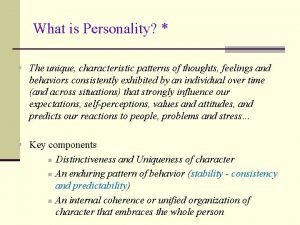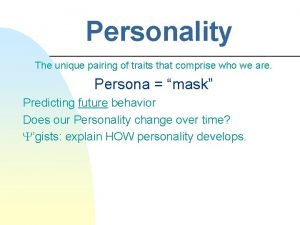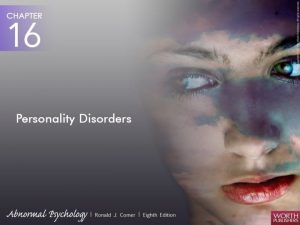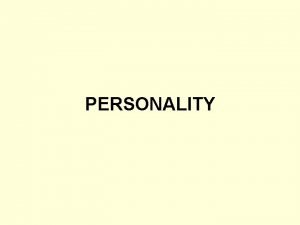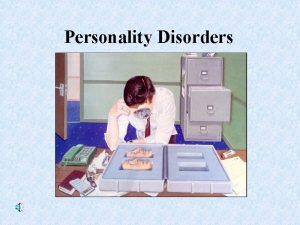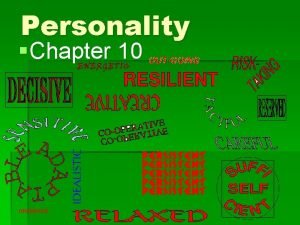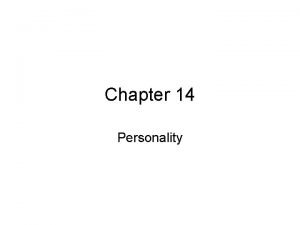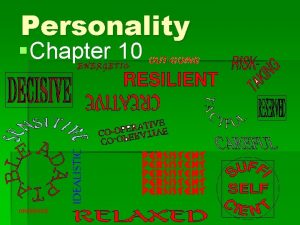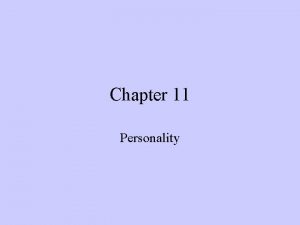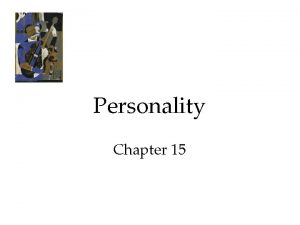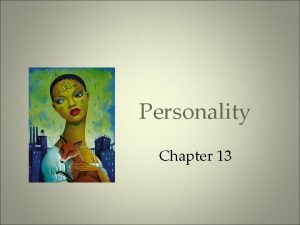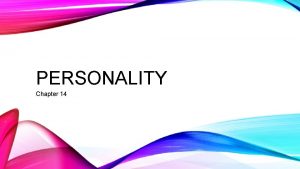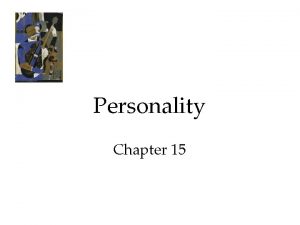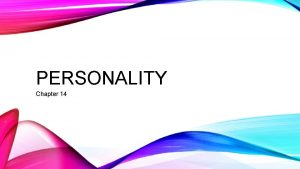Personality Chapter 11 Personality Definition the unique pattern






























- Slides: 30

Personality Chapter 11

Personality Definition: the unique pattern of enduring thoughts, feelings, & actions that characterize a person. l To fully understand an individual’s personality you have to learn a person’s: developmental experiences, cultural influences, genetic & other biological characteristics, perceptual and other informationprocessing habits and biases, typical patterns of emotional expression & social skills. l 5 Elements of Personality: • Introversion versus Extroversion • Neuroticism • Agreeableness • Conscientiousness • Openness to new experiences

Sigmund Freud and the Psychodynamic theory The 5 basic elements are: Intrapsychic dynamics – movement of psychic forces within the mind. Adult behavior and current problems are linked to early childhood experiences. Psychological development occurs in fixed stages. Psychic reality – focus on fantasies & symbolic meanings of events as motivators in behavior. Reliance on subjective methods of getting to the truth.

Ego Freud’s Structure of Personality Super Ego Any action we take or problem we have are related to the interaction of these 3 systems: Id

Id – unconscious, psychological energies & instincts and operates on the Pleasure Principles a. Life or sexual instincts (Libido) b. Death or aggressive instincts Tension is the result of a build up of energy in the Id. Ex: “I’m so mad I could kill you. ” ID

Ego – unconscious & conscious - based on Reality Principles. a. Represents reason and good sense b. Mediator between Id and Superego Ex: “Let’s talk about this” or uses denial, “What, me angry? ”

Superego – little conscious but mostly unconscious, is morality, rules of parents & authority. a. Judges the activities and thoughts of the Id. Ex: “Thou shalt not kill. ” A healthy personality keeps all 3 systems in check. Super Ego

Defense Mechanisms Ego uses these weapons to release tension between Id and Superego. The weapons deny or distort reality. 1. Repression – blocking threatening memories, emotions, or thoughts. 2. Projection – own unacceptable feelings are attributed to someone else. 3. Displacement – putting emotions towards an animal, person, object that is not the cause of the emotion. 4. Regression – a reversal to a previous stage of development. 5. Denial – a refusal to admit that something unpleasant is happening or are having “forbidden” thoughts or emotions.

Personality Development 1. Oral stage – first year of life. Life experienced through mouth. Symptoms: nail biting, overeating, smoking, etc. 2. Anal stage – about age 2 – 3 years. Starts ego development & awareness of self. a. Anal retentive – holds everything in, neatness and cleanliness is important. b. Anal expulsive – unorganized or messy. 3. The phallic or Oedipal stage – ages 3 – 6. Awareness of sexual sensations. a. Desire to get rid of the parent of the same sex. b. Superego is formed. c. Age 5 – 6 personality pattern are formed at the end of stage. 4. The latency stage – lasts from the end of phallic stage to puberty. a. Sexual feelings are dormant and repressed. b. Child settles down goes to school & learns social rules. 5. The genital stage – begins at puberty & begins adult sexuality Focus: intercourse

Jungian Theory Carl Jung was a friend of Freud’s but they disagreed on the Nature of the Unconscious. Jung’s theory: there is an individual unconscious and a collective unconscious. Collective unconscious - Universal myths, images, symbols, art, & memories

Archetypes Common themes of the collective unconscious Mandala – is the wholeness or the totality of the self Anima – feminine side of men Animus – male side of women

Persona – outward expression of one’s self Shadow – sinister, evil side of human self People are motivated by past conflicts as well as by future goals and desires to fulfill themselves. A more positive idea of the Ego.

Carl Jung People born w/ a general life force includes sex & creative drives, conflict resolution, & blend impulses w/ real world demands. l People develop degrees of intro & extroversion. l Karen Horney l Argued against “penis envy, ” females envious of men, with “womb envy, ” because men can’t bear children they feel their lives have less meaning. Object Relation Theory Child’s early relationship w/ their love objects(mother or caregiver) l These relationships shape our social relationships later in life. l Attachment Theory l Infants form a secure bond to their mothers & gradually tolerate separation from this “ attachment object” & then relate to others as independent, secure individuals.

Psychodynamic Theory: Criticisms & Applications Criticisms: l Conclusions about personality are based on case studies of women w/ psych. Problems, rich & in a culture where discussing sex was uncivilized. l Theory reflects W. European & N. American cultural values, not necessarily helpful for people of other cultures. l May have modified reports of sessions to fit his theories. l May have asked leading questions & influenced recall of memories. Applications: l Theories have shaped wide range of psychotherapy techniques & stimulated development of several personality assessment. l Support from research on cognitive processes. l Others have used the defense mechanisms.

Trait Approach 3 Main Assumptions 1. 2. 3. Personality traits are relatively stable & predictable over time. Personality traits are relatively stable & predictable across situations. Endless variety of unique personalities. Trait Approach – personality is a combination of stable characteristics that people display over time and across situations. Gordon Allport’s Trait Theory Central Traits – traits that are usually obvious to others & organize & control behavior. Secondary Traits – traits that are more specific to certain situations & control less behavior. Big Five Model (Five-factor Model) – Openness, Conscientiousness, Extraversion, Agreeableness & Neuroticism.

Biological Trait Theory Eysenck’s Biological Trait Theory l 1. 2. Focuses on 2 main personality dimensions: Introversion-Extroversion Emotionality-Stability l Personality can be described by where a person falls on the chart. l Differences in personalities can be attributed to genetic differences in their nervous systems.

Gray’s Approach-Inhibition Theory l Differences among people in introversion-extroversion & emotionality -stability from 2 related systems in the brain: – BAS(Behavioral Approach System) is responsible for how impulsive or uninhibited a person is. – BIS(Behavioral Inhibition System) is responsible for how fearful or inhibited a person is. – Gray’s theory more acceptable then Eysenck’s – because it is supported by what neuroscientists have learned about brain structures, neurotransmitters & how they operate. l Evaluating the Trait Approach – Better at describing people than understanding them. – Don’t say much about how traits are related to the thoughts & feelings that precede, accompany & follow behavior. – Provide a shallow description of personality that fails to capture the complexities of an individual’s personalities in different situations.

Social-Cognitive Approach Full set of behaviors people have acquired thru learning & are displayed in particular situations. l Expands Behaviorist theory, learned behavior comes from Classical & Operant Conditioning. l – Learned patterns of thinking guide behavior – Personality learned in social situations, observing & interacting. l Rotter’s Expectancy Theory – What the person expects to happen following the behavior. – The value the person places on outcome. – Other aspects of Rotter’s Theory l l l Learn general expectancies about how rewards and punishments are controlled. Internal – events under your control External – events out of their control, chance or luck

l Bandura and Reciprocal Determinism – Personality shaped by the way in which thoughts, behavior and environment interact & influence each other. – Reciprical Determinism – behavior changes environment and which changes how we think which changes our behavior, so on and so on. – Self-eficacy- the learned expectation of success. l The Little Engine That Could Mischel’s Cognitive/Affective Theory – “if-then” theory § Cognitive Person Variables § § § Encodings Expectancies Affects Goals and values Competencies and self-regulatory plans § The person and the situation interact to produce a behavior

Mischel and Bandura l Personal dispositions influence behavior only in relevant situations. l Personal dispositions can lead to behaviors that alter situations & promote other behaviors. l People choose to be in situations that are in line with their personal dispositions. l Personal dispositions are more important in some situations than in others.

Social – Cognitive Approach l l l It blends behavioral learning with cognitive psychology and applies them to socially important topics. Have affected treatment procedures. No role for unconscious thoughts and feelings effecting behavior. Focus on why traits are unimportant than why situations are important. Failed to identify what it is about certain situations that brings out certain behaviors. Some feel that it can’t capture the richness, complexities and uniqueness that are inherent in personalities.

Humanistic Approach l Focus: self-awareness, creativity, planning, decision making & responsibility l Behavior motivated by innate drive toward growth to fulfill their potential. l Must understand personal perspective (phenomenology) to understand behavior.

Carl Roger’s Self Theory l “self” is center of his theory. Must accurately experience your “self” l Actualizing tendency – innate inclination toward growth and fulfillment. l Self-concept – the way one thinks of themselves. l Positive regard – learn to need the approval of others. This evaluation effects a child’s own self-evaluations. Socialization begins here. l Personality is view of self & evaluations of others. l Disorders can result when feelings we experience or express are incongruent with our view of our “self” l Conditions of Worth – when people are evaluated instead of their behavior.

l Abraham Maslow – Personality is the expression of a basic human tendency toward growth & self-actualization. – Most people controlled by a deficiency orientation – preoccupation with perceived needs for material thingswhat is missing in their life. – Growth orientation – focus on what is missing but on what they have, what they are and what they can do. l Opens door to peak experiences feelings of joy, ecstasy

Evaluating the Humanistic Approach Inspired otherapies; sensitivity training § Some view this approach as naïve, romantic and unrealistic. § Pay too little attention to role of inherited characteristics, learning, situational influences & unconscious motivations in shaping personality. § Define ideal personality development in terms of personal growth, independence, & self-actualization. Which may go against a collectivist culture. §

Assessing Personalities § Four Methods • • § Life outcomes Situational Tests Observer Ratings Self-Reports Objective Personality Tests – • • • § Asks clear questions about a person’s thoughts, feelings, or behavior; MC or T/F Efficient & Standardized Subject to deliberate distortion Projective Personality Tests – • • • Items or tasks are ambiguous, no clear answer; Rorschach Inkblot Test. Correct answers not obvious Designed to tap unconscious impulses




 The unique pattern of characteristic thoughts
The unique pattern of characteristic thoughts Pattern of thinking feeling and acting
Pattern of thinking feeling and acting Unique pairing personality
Unique pairing personality Chapter 21 a unique prosperous and discontented time
Chapter 21 a unique prosperous and discontented time Hát kết hợp bộ gõ cơ thể
Hát kết hợp bộ gõ cơ thể Slidetodoc
Slidetodoc Bổ thể
Bổ thể Tỉ lệ cơ thể trẻ em
Tỉ lệ cơ thể trẻ em Chó sói
Chó sói Tư thế worm breton là gì
Tư thế worm breton là gì Alleluia hat len nguoi oi
Alleluia hat len nguoi oi Các môn thể thao bắt đầu bằng tiếng chạy
Các môn thể thao bắt đầu bằng tiếng chạy Thế nào là hệ số cao nhất
Thế nào là hệ số cao nhất Các châu lục và đại dương trên thế giới
Các châu lục và đại dương trên thế giới Công của trọng lực
Công của trọng lực Trời xanh đây là của chúng ta thể thơ
Trời xanh đây là của chúng ta thể thơ Mật thư tọa độ 5x5
Mật thư tọa độ 5x5 Phép trừ bù
Phép trừ bù độ dài liên kết
độ dài liên kết Các châu lục và đại dương trên thế giới
Các châu lục và đại dương trên thế giới Thơ thất ngôn tứ tuyệt đường luật
Thơ thất ngôn tứ tuyệt đường luật Quá trình desamine hóa có thể tạo ra
Quá trình desamine hóa có thể tạo ra Một số thể thơ truyền thống
Một số thể thơ truyền thống Cái miệng bé xinh thế chỉ nói điều hay thôi
Cái miệng bé xinh thế chỉ nói điều hay thôi Vẽ hình chiếu vuông góc của vật thể sau
Vẽ hình chiếu vuông góc của vật thể sau Thế nào là sự mỏi cơ
Thế nào là sự mỏi cơ đặc điểm cơ thể của người tối cổ
đặc điểm cơ thể của người tối cổ V. c c
V. c c Vẽ hình chiếu đứng bằng cạnh của vật thể
Vẽ hình chiếu đứng bằng cạnh của vật thể Tia chieu sa te
Tia chieu sa te Thẻ vin
Thẻ vin
